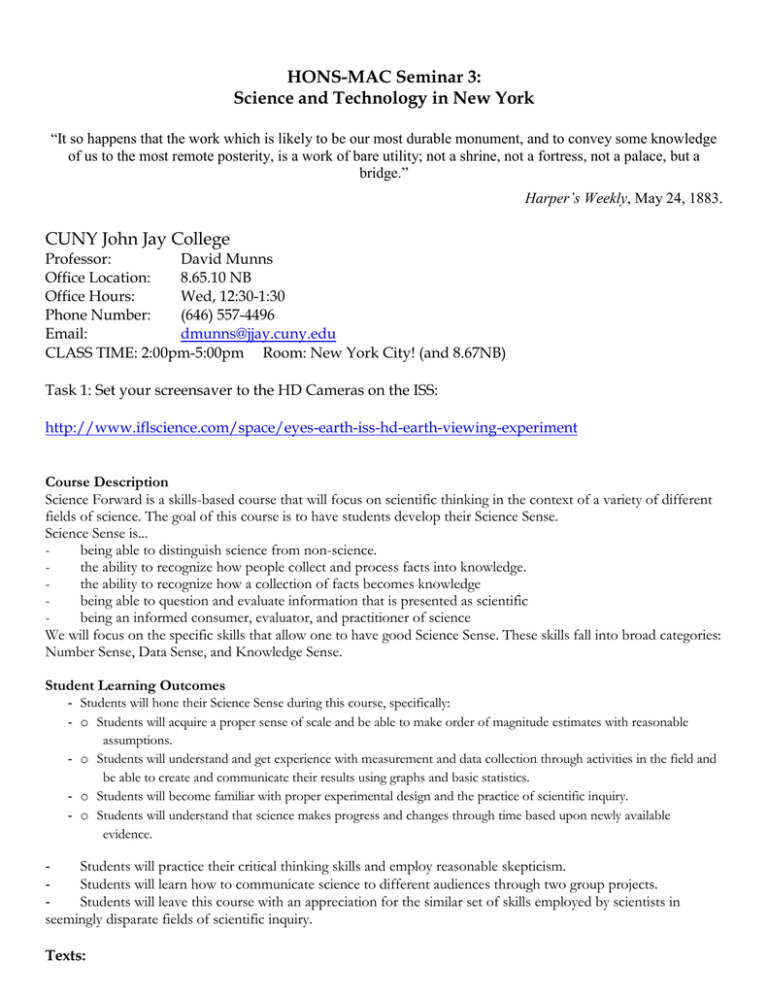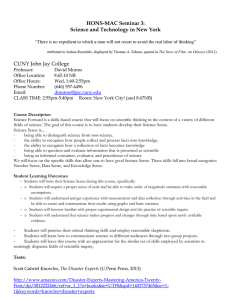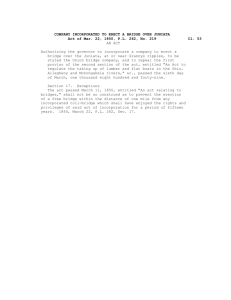- Macaulay Honors College
advertisement

HONS-MAC Seminar 3: Science and Technology in New York “It so happens that the work which is likely to be our most durable monument, and to convey some knowledge of us to the most remote posterity, is a work of bare utility; not a shrine, not a fortress, not a palace, but a bridge.” Harper’s Weekly, May 24, 1883. CUNY John Jay College Professor: David Munns Office Location: 8.65.10 NB Office Hours: Wed, 12:30-1:30 Phone Number: (646) 557-4496 Email: dmunns@jjay.cuny.edu CLASS TIME: 2:00pm-5:00pm Room: New York City! (and 8.67NB) Task 1: Set your screensaver to the HD Cameras on the ISS: http://www.iflscience.com/space/eyes-earth-iss-hd-earth-viewing-experiment Course Description Science Forward is a skills-based course that will focus on scientific thinking in the context of a variety of different fields of science. The goal of this course is to have students develop their Science Sense. Science Sense is... being able to distinguish science from non-science. the ability to recognize how people collect and process facts into knowledge. the ability to recognize how a collection of facts becomes knowledge being able to question and evaluate information that is presented as scientific being an informed consumer, evaluator, and practitioner of science We will focus on the specific skills that allow one to have good Science Sense. These skills fall into broad categories: Number Sense, Data Sense, and Knowledge Sense. Student Learning Outcomes - Students will hone their Science Sense during this course, specifically: - o Students will acquire a proper sense of scale and be able to make order of magnitude estimates with reasonable assumptions. - o Students will understand and get experience with measurement and data collection through activities in the field and be able to create and communicate their results using graphs and basic statistics. - o Students will become familiar with proper experimental design and the practice of scientific inquiry. - o Students will understand that science makes progress and changes through time based upon newly available evidence. Students will practice their critical thinking skills and employ reasonable skepticism. Students will learn how to communicate science to different audiences through two group projects. Students will leave this course with an appreciation for the similar set of skills employed by scientists in seemingly disparate fields of scientific inquiry. Texts: Scott Gabriel Knowles, The Disaster Experts (U.Penn Press, 2013) http://www.amazon.com/Disaster-Experts-Mastering-America-TwentyFirst/dp/0812222466/ref=sr_1_1?s=books&ie=UTF8&qid=1403757465&sr=11&keywords=knowles+disaster+experts David McCullough, The Great Bridge (Simon and Schuster, 1972). http://www.amazon.com/The-Great-Bridge-BuildingBrooklyn/dp/067145711X/ref=sr_1_1?ie=UTF8&qid=1403757190&sr=81&keywords=mccullough+the+great+bridge Mark Essig, Edison and the Electric Chair (Walker Books, 2009) http://www.amazon.com/Edison-Electric-Chair-Mark-Essigebook/dp/B002WC6HL0/ref=sr_1_sc_1?ie=UTF8&qid=1403757250&sr=8-1spell&keywords=edison+and+the+lectroc+chair Judith Leavitt, Typhoid Mary: Captive to the Public’s Health ( http://www.amazon.com/Typhoid-Mary-Captive-PublicsHealth/dp/0807021032/ref=la_B001IU0K56_1_1?s=books&ie=UTF8&qid=1403757433&sr=1-1 Above ALL you need a driven curiosity Papers: Class Attendance and Participation. (15%) (essentially 1% per day per participation) One excused absence. 1st Homework (5%): Due Sept 10th. 1st Task (5%): Due Sept 10th. 2nd Task: (10%) Due Oct 8th. First Paper: (25%): Due Oct 15th. TOPIC: What is the process by which bridge engineers learnt about the phenomena known as ‘Caisson’s Disease’? What were the significant problems presented by the phenomena in the late-19th century? What actions did the bridge engineers take to alleviate the disease? Explain and evaluate the justification and legitimacy of those steps (or non-steps [things they considered by decided not to pursue]). Final Paper (40%): Due Mon Dec 15th @ 5pm. No late assignments will be accepted. Attendance Policy: Please come to class on time, with your cell phone turned off. There are no make-ups for missed assignments, and more than two absences will seriously affect your grade in the course. If you are more than fifteen minutes late, it will also count as an absence. NB: everyone has problems either settling on a topic, or finding material, or starting, or finishing, or all of the above! The idea is to be able to identify your problem and work through it with guidance. If you need assistance outside of these times, please don’t hesitate to email me your question in detail, and I can answer or schedule a meeting, or point you in the right direction, or all of the above! Office Hours: I have listed my office hours at the top of the syllabus—please come visit if you have any questions about course requirements, the things we talk about in class, the readings and assignments, study strategies, John Jay, special concerns, letters of recommendation, graduate school, or anything else. I am here to help you succeed. Plagiarism: Plagiarism is the act of presenting another person's ideas, research or writings as your own. Here are some examples of plagiarism: Copying another person’s actual words without the use of quotation marks and footnotes attributing the words to their source Presenting another person’s ideas or theories in your own words without acknowledging the source Using information that is not common knowledge without acknowledging the sources Failing to acknowledge collaborators on homework and laboratory assignments Submitting downloaded term papers or part of term papers, paraphrasing or copying information from the Internet without citing the source, and "cutting and pasting" from various sources without proper attribution. In order to ensure that you clearly understand what plagiarism is, you MUST complete a graded online tutorial and quiz through Blackboard. Please note that Blackboard automatically checks all your writing for plagiarism, and that a single act of plagiarism—or any other form of academic dishonesty—can result in a failing grade for the assignment or the course. Please see me if you have any questions about this. Grades: In accordance with CUNY policy, your grade in this course will reflect the following scale: A B C D F Excellent (90-100%) Good (80-89%) Satisfactory (70-79%) Passing (60-69%) Failure/Unsuccessful Completion of the Course (less than 59%) What I Expect From You and What You Can Expect from Me: This syllabus spells out exactly what this course requires. In order for you to get the most out of the semester I expect you to review this syllabus on a regular basis, complete the readings and assignments punctually, check your John Jay email regularly, come to class ready to learn, and participate thoughtfully and respectfully in our discussions. In turn, I will be clear about my expectations, avoid wasting your time or giving you busy work that serves no purpose, answer all your questions about the requirements and material, grade your work fairly and promptly, and provide you with everything that you need to succeed in this course. Course Schedule Wed Sept 3rd: Introduction: What is “Science”? What is the “science sense” we hope to develop? 1. 2. 3. 4. How do you make a Pencil? What is “Risk”? What is “knowledge” and what is “epistemology”? How are claims “proven”? “legitimated”? Homework: what are the issues at stake in the following video?: https://www.youtube.com/watch?v=ZPv1UV0rD8U Sept 10: DO: Look over the web-story, ’10 Algorithms that dominate your life’ http://io9.com/the-10-algorithms-that-dominate-our-world1580110464/+whitsongordon?utm_content=bufferde673&utm_medium=social&utm_source=faceboo k.com&utm_campaign=buffer TASK for class: Investigate one algorithm of interest to explain when called on in class, how it works and what it does. READ: Knowles, The Disaster Experts, Introduction. PREPARE: Think about what elements would be incorporated into an Algorithm of Risk? Sept 17: Case Study 1: Typhoid Mary READ: Leavitt, Typhoid Mary, chapts PREPARE: Think about what elements would be incorporated into an Algorithm of Disease Risk? Sept 24 : No CLASSES SCHEDULED AT John Jay College. Oct 1: Case Study 2: The Brooklyn Bridge. Caissons and Pressure. READ: McCullough, The Great bridge, Chapts 1-5; 7-9 pp. 245-47. TASK for Class: Submit a Force diagram showing all the forces at work inside the Caisson. PREPARE: Think about what elements would be incorporated into an Algorithm of Labor Risk? http://www.bbc.com/news/science-environment-17013285 Oct 8 The Great Bridge: Ferries and Slender Steel Cables READ: McCullough, The Great bridge, Chapt 13-16; 21-Epilogue. Oct 15: No CLASS: Dr. Munns must attend a conference. 1st Paper Due! TOPIC: What is the process by which bridge engineers learnt about the phenomena known as ‘Caisson’s Disease’? What were the significant problems presented by the phenomena in the late-19th century? What actions did the bridge engineers take to alleviate the disease? Explain and evaluate the justification and legitimacy of those steps (or non-steps [things they considered by decided not to pursue]). 1500 words ±10% : please email. Oct 22 Case Study 3: The Electric Chair READ: Essig, Edison and the Electric Chair, chapts 6-9; 11-13; 15; 23. + READ: Reynolds and Bernstein, Edison and ‘The Chair’ PREPARE: Think about what elements would be incorporated into an Algorithm of Death Penalty Risk? Supplementary Reading: Prof Evan Mandery, A Wild Justice: the death and resurrection of capital punishment in America. http://www.amazon.com/Wild-Justice-Resurrection-CapitalPunishment/dp/0393239586/ref=sr_1_1?ie=UTF8&qid=1403761846&sr=81&keywords=evan+mandery Oct 29 Case Study 4: Industrial Disasters and Fire READ: Knowles, The Disaster Experts, Chapter 2. PLUS PREPARE: Think about what elements would be incorporated into an Algorithm of Fire Risk? Nov 5 Case Study 5: Moving the Obelisk: READ: Cleopatra’s Needles: Lond and new York, in Curran, Grafton, Long & Weiss, Obelisk: a history (MIT Press, 2009(: 257-282; PREPARE: Think about what elements would be incorporated into the risk of moving an obelisk? Nov 12 Case Study 6: Violence READ: Christina B. Hanhardt, Safe Space: Gay Neighborhood History and the Politics of Violence (Duke University Press, 2013), Intro + Chapter 2. PREPARE: Think about what elements would be incorporated into an Algorithm of Violence Risk? TASK: Diagram Nov 19 What is a Disaster? READ Knowles, The Disaster Experts, Chapter 5. PREPARE: What aspect of Risk are you going to investigate? Nov 26 Individual Meetings to Discuss your topic, methods of investigation, data collection, etc Dec 3 Individual Meetings TASK: One-Page synopsis Dec 10: Class Presentations : receive comments from 2 peers. Final Posters due BIBLIOGRAPHY Some histories of particular things Alan Macfarlane & Gerry Martin Glass: A World History, (London, 2002). Henry Petroski, The Pencil: A History of Design and Circumstance, (New York, 989). Mark Kurlansky Salt: A World History, (London, 2001). Witold Rybczynski, One Good Turn: A Natural History of the Screwdriver and the Screw, (New York, 2000.) Alison J. Clarke Tupperware: the Promise of Plastic in 1950s America, (Washington, 1999). Robert Friedel, Zipper: An Exploration in Novelty, (New York, 1994). Henry Petroski, The Evolution of Useful Things: How Everyday Artifacts-From Forks and Pins to Paper Clips and Zippers-Came to Be As They Are, (New York, 1992). Some studies of things in use Siegfried Giedion, Mechanization takes Command: a contribution to anonymous history (1948) Ruth Schwartz Cowan, More Work for Mother: The Ironies of Household Technology from the Open Hearth to the Microwave (1985). Christina Hardyment, From mangle to microwave: the mechanization of household work. (1988). Ronald R. Kline, Consumers in the Country: Technology and Social Change in Rural America (2000). David Nye, Electrifying America: Social Meanings of the New Technology, 1880-1940 (1990). Jeffrey L. Meikle, American Plastic: A Cultural History (1995). C. Fischer, America Calling: A Social History of the Telephone to 1940 (Berkeley, 1992) K. Jellison, Entitled to Power: Farm Women and American Technology (Chapel Hill, 1993). Cynthia Cockburn and Susan Ormrod, Gender and Technology in the Making (London, 1993) C.Chant (ed.), Science, technology and everyday life, 1870-1950 (London, 1989) Histories of Invention/Technology Robert Bud et al., Inventing the modern world: Technology since 1750 (Science Museum: London, 2000). Donald Cardwell, The Fontana History of Technology (London, 1994) R.A. Buchanan, The Power of the Machine: the impact of technology from 1700 to the present (Harmondsworth, 1992) Some histories of US technology Ruth Schwartz Cowan, A Social History of American Technology (New York: Oxford University Press, 1997) Carroll Pursell, The Machine in America: A social history of technology (Baltimore, 1995) David Hounshell, From the American System to Mass Production, 1800-1932: the development of manufacturing technology in the United States (Baltimore, 1984) Some other works of particular interest T.P. Hughes, Networks of Power: Electrification in Western Society, 1880-1930 (Baltimore: Johns Hopkins University Press, 1983); David F. Noble, Forces of Production: a social history of automation (New York: Oxford University Press, 1985); S. Brand, How Buildings Learn: What Happens after they're Built (London: Penguin, 1994). Brian Winston, Media, Technology and Society, A History: From the telegraph to the internet (London: Routledge, 1998






